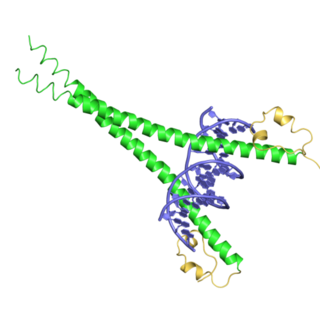Related Research Articles

Klotho is an enzyme that in humans is encoded by the KL gene. The three subfamilies of klotho are α-klotho, β-klotho, and γ-klotho. α-klotho activates FGF23, and β-klotho activates FGF19 and FGF21. When the subfamily is not specified, the word "klotho" typically refers to the α-klotho subfamily, because α-klotho was discovered before the other members.

Bile acids are steroid acids found predominantly in the bile of mammals and other vertebrates. Diverse bile acids are synthesized in the liver. Bile acids are conjugated with taurine or glycine residues to give anions called bile salts.
Fibroblast growth factors (FGF) are a family of cell signalling proteins produced by macrophages; they are involved in a wide variety of processes, most notably as crucial elements for normal development in animal cells. Any irregularities in their function lead to a range of developmental defects. These growth factors typically act as systemic or locally circulating molecules of extracellular origin that activate cell surface receptors. A defining property of FGFs is that they bind to heparin and to heparan sulfate. Thus, some are sequestered in the extracellular matrix of tissues that contains heparan sulfate proteoglycans and are released locally upon injury or tissue remodeling.

The bile acid receptor (BAR), also known as farnesoid X receptor (FXR) or NR1H4, is a nuclear receptor that is encoded by the NR1H4 gene in humans.

The liver X receptor (LXR) is a member of the nuclear receptor family of transcription factors and is closely related to nuclear receptors such as the PPARs, FXR and RXR. Liver X receptors (LXRs) are important regulators of cholesterol, fatty acid, and glucose homeostasis. LXRs were earlier classified as orphan nuclear receptors, however, upon discovery of endogenous oxysterols as ligands they were subsequently deorphanized.

In the field of molecular biology, the pregnane X receptor (PXR), also known as the steroid and xenobiotic sensing nuclear receptor (SXR) or nuclear receptor subfamily 1, group I, member 2 (NR1I2) is a protein that in humans is encoded by the NR1I2 gene.

Cholesterol 7 alpha-hydroxylase also known as cholesterol 7-alpha-monooxygenase or cytochrome P450 7A1 (CYP7A1) is an enzyme that in humans is encoded by the CYP7A1 gene which has an important role in cholesterol metabolism. It is a cytochrome P450 enzyme, which belongs to the oxidoreductase class, and converts cholesterol to 7-alpha-hydroxycholesterol, the first and rate limiting step in bile acid synthesis.

Retinoid X receptor alpha (RXR-alpha), also known as NR2B1 is a nuclear receptor that in humans is encoded by the RXRA gene.

Liver X receptor alpha (LXR-alpha) is a nuclear receptor protein that in humans is encoded by the NR1H3 gene.

Transcription factor MafG is a bZip Maf transcription factor protein that in humans is encoded by the MAFG gene.

UDP glucuronosyltransferase 2 family, polypeptide B4, also known as UGT2B4, is an enzyme that in humans is encoded by the UGT2B4 gene.

Tumor necrosis factor receptor superfamily member 12A also known as the TWEAK receptor (TWEAKR) is a protein that in humans is encoded by the TNFRSF12A gene.

Fibroblast growth factor 19 is a protein that in humans is encoded by the FGF19 gene. It functions as a hormone, regulating bile acid synthesis, with effects on glucose and lipid metabolism. Reduced synthesis, and blood levels, may be a factor in chronic bile acid diarrhea and in certain metabolic disorders.

Fibroblast growth factor 21 is a protein that in mammals is encoded by the FGF21 gene. The protein encoded by this gene is a member of the fibroblast growth factor (FGF) family and specifically a member of the endocrine subfamily which includes FGF23 and FGF15/19. FGF21 is the primary endogenous agonist of the FGF21 receptor, which is composed of the co-receptors FGF receptor 1 and β-Klotho.
Bile acid malabsorption (BAM), known also as bile acid diarrhea, is a cause of several gut-related problems, the main one being chronic diarrhea. It has also been called bile acid-induced diarrhea, cholerheic or choleretic enteropathy, bile salt diarrhea or bile salt malabsorption. It can result from malabsorption secondary to gastrointestinal disease, or be a primary disorder, associated with excessive bile acid production. Treatment with bile acid sequestrants is often effective. It is recognised as a disability in the United Kingdom under the Equality Act 2010

7α-Hydroxy-4-cholesten-3-one is an intermediate in the biochemical synthesis of bile acids from cholesterol. Its precursor, 7α-hydroxycholesterol, is produced from cholesterol by hepatic cholesterol 7α-hydroxylase (CYP7A1).
FGF15/19 refers to two orthologous fibroblast growth factors which share 50% aminoacid identity and have similar functions. FGF15 was described in the mouse; FGF19 was found in humans and other species. They share physiological functions and so are often referred to as FGF15/19 or as FGF15/FGF19.

Obeticholic acid (OCA), sold under the brand name Ocaliva, is a semi-synthetic bile acid analogue which has the chemical structure 6α-ethyl-chenodeoxycholic acid. It is used as a medication used to treat primary biliary cholangitis. Intercept Pharmaceuticals Inc. hold the worldwide rights to develop OCA outside Japan and China, where it is licensed to Dainippon Sumitomo Pharma.

Fexaramine is an investigational compound which acts as an agonist of the farnesoid X receptor (FXR), which is a bile acid-activated nuclear receptor that controls bile-acid synthesis, conjugation and transport, as well as lipid metabolism through actions in the liver and intestine.

David Dudley Moore is an American molecular biologist known for his work investigating nuclear hormone receptors. He is a Professor and Chair of the Department of Nutritional Sciences & Toxicology at the University of California, Berkeley. He was a founding editor for the Current Protocols series of laboratory manuals in 1987.
References
- ↑ NCBI. "Mouse FGF15 fibroblast growth factor 15".
- ↑ Jones SA (2012). "Physiology of FGF15/19". Endocrine FGFS and Klothos. Advances in Experimental Medicine and Biology. Vol. 728. pp. 171–82. doi:10.1007/978-1-4614-0887-1_11. ISBN 9781461408871. PMID 22396169.
- ↑ Potthoff MJ, Kliewer SA, Mangelsdorf DJ (Feb 2012). "Endocrine fibroblast growth factors 15/19 and 21: from feast to famine". Genes & Development. 26 (4): 312–324. doi:10.1101/gad.184788.111. PMC 3289879 . PMID 22302876.
- ↑ McWhirter JR, Goulding M, Weiner JA, Chun J, Murre C (Sep 1997). "A novel fibroblast growth factor gene expressed in the developing nervous system is a downstream target of the chimeric homeodomain oncoprotein E2A-Pbx1". Development. 124 (17): 3221–32. doi:10.1242/dev.124.17.3221. PMID 9310317.
- ↑ Gimeno L, Hashemi R, Brûlet P, Martínez S (2002). "Analysis of Fgf15 expression pattern in the mouse neural tube". Brain Research Bulletin. 57 (3–4): 297–9. doi:10.1016/S0361-9230(01)00717-1. PMID 11922976. S2CID 3084522.
- ↑ Gimeno L, Brûlet P, Martínez S (Aug 2003). "Study of Fgf15 gene expression in developing mouse brain". Gene Expression Patterns. 3 (4): 473–81. doi:10.1016/S1567-133X(03)00059-0. PMID 12915315.
- ↑ Wright TJ, Ladher R, McWhirter J, Murre C, Schoenwolf GC, Mansour SL (May 2004). "Mouse FGF15 is the ortholog of human and chick FGF19, but is not uniquely required for otic induction". Developmental Biology. 269 (1): 264–75. doi: 10.1016/j.ydbio.2004.02.003 . PMID 15081372.
- ↑ Inagaki T, Choi M, Moschetta A, Peng L, Cummins CL, McDonald JG, Luo G, Jones SA, Goodwin B, Richardson JA, Gerard RD, Repa JJ, Mangelsdorf DJ, Kliewer SA (Oct 2005). "Fibroblast growth factor 15 functions as an enterohepatic signal to regulate bile acid homeostasis". Cell Metabolism. 2 (4): 217–25. doi: 10.1016/j.cmet.2005.09.001 . PMID 16213224.
- ↑ Jung D, Inagaki T, Gerard RD, Dawson PA, Kliewer SA, Mangelsdorf DJ, Moschetta A (Dec 2007). "FXR agonists and FGF15 reduce fecal bile acid excretion in a mouse model of bile acid malabsorption". Journal of Lipid Research. 48 (12): 2693–700. doi: 10.1194/jlr.M700351-JLR200 . PMID 17823457.
- ↑ Kir S, Beddow SA, Samuel VT, Miller P, Previs SF, Suino-Powell K, Xu HE, Shulman GI, Kliewer SA, Mangelsdorf DJ (Mar 2011). "FGF19 as a postprandial, insulin-independent activator of hepatic protein and glycogen synthesis". Science. 331 (6024): 1621–4. Bibcode:2011Sci...331.1621K. doi:10.1126/science.1198363. PMC 3076083 . PMID 21436455.
- ↑ Zhang L, Wang YD, Chen WD, Wang X, Lou G, Liu N, Lin M, Forman BM, Huang W (Dec 2012). "Promotion of liver regeneration/repair by farnesoid X receptor in both liver and intestine in mice". Hepatology. 56 (6): 2336–43. doi:10.1002/hep.25905. PMC 3477501 . PMID 22711662.
- ↑ Kong B, Huang J, Zhu Y, Li G, Williams J, Shen S, Aleksunes LM, Richardson JR, Apte U, Rudnick DA, Guo GL (May 2014). "Fibroblast growth factor 15 deficiency impairs liver regeneration in mice". American Journal of Physiology. Gastrointestinal and Liver Physiology. 306 (10): G893–902. doi:10.1152/ajpgi.00337.2013. PMC 4024724 . PMID 24699334.